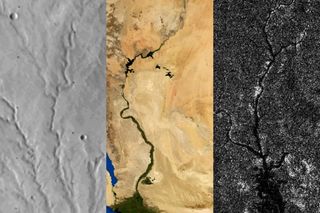Rivers of Saturn's Moon Titan Reveal Mars-Like Evolution

The evolution of the hydrocarbon-rich surface on Saturn's largest moon, Titan, may have more in common with the history of Mars' dusty landscape than with Earth's dynamic geology, scientists said in new research.
By studying the flow of river channels etched into the surfaces of Titan, Mars and Earth, researchers at the Massachusetts Institute of Technology (MIT) found that Titan's topography (surface elevations) more resemble the Red Planet than Earth.
The new study, published today (May 18) in the journal Science, also found that Titan has not undergone significant tectonic activity in the recent past. [Hydrocarbon Rivers Flow in Titan's Deep Canyons | Video]
"While the processes that created Titan's topography are still enigmatic, this [research] rules out some of the mechanisms we're most familiar with on Earth," said lead author Benjamin Black, formerly an MIT graduate student and now an assistant professor at the City College of New York.

How rivers shaped Earth, Mars (and Titan?)
The paths of river networks are intimately tied to the evolution of a planet's topography. On Earth, the motion of tectonic plates continually reshapes the landscape, pushing the crust upward and creating mountains. Rivers react to these obstacles, carving out new channels along paths of least resistance to reach the oceans.
Mars' landscape, on the other hand, was shaped mostly by massive asteroid impacts during the Late Heavy Bombardment in the Red Planet's formative years, when vast impact craters were blasted out and huge volcanoes grew. So, any rivers that carved out the ancient channels seen on Mars' parched surface today were not influenced by modern tectonic activity. [How Mars Was Made (Earth, Venus & Mercury, Too)]
To gain a better understanding of how Titan's topology evolved, the researchers in the new study compared observations of river networks on Earth, Titan and Mars. Using Titan observations made by NASA's Cassini mission and superimposing them with river networks observed on Earth and Mars, the scientists made notes on how the direction of flow compares with changes in elevation on each world, a metric the researchers called "topographic conformity."
Get the Space.com Newsletter
Breaking space news, the latest updates on rocket launches, skywatching events and more!
"We know something about rivers and something about topography, and we expect that rivers are interacting with topography as it evolves," Black said in a statement. "Our goal was to use those pieces to crack the code of what formed the topography in the first place."
A cousin of Mars?
The scientists found that the rivers of Titan have more in common with the ancient rivers of Mars. This means the Saturn moon hasn't exhibited tectonic activity for a long time and the early topography of the moon was more likely influenced by the tides of Saturn, which caused changes in the thickness of ice under the moon's surface, the researchers suggested.
"It's remarkable that there are three worlds in the solar system where flowing rivers have carved into the landscape, either presently or in the past," said co-author Taylor Perron, associate professor of geology in MIT's Department of Earth, Atmospheric and Planetary Sciences (EAPS) in the same statement. "There's this amazing opportunity to use the landforms the rivers have created to learn how the histories of these worlds are different."
Scientists have observed several similarities between Titan and Earth; the thick atmosphere and liquid seas on the Saturn satellite certainly appear to have terrestrial qualities, researchers have said. The moon's methane cycle is also analogous to Earth's water cycle, in which water evaporates into the atmosphere, condenses into clouds and precipitates onto the landscape, creating rivers that flow back into the seas. A similar process is underway in Titan’s atmosphere, just swap the water for methane. But as this new research shows, the scientists said, the similarities to Earth are limited to Titan's atmosphere; the evolution of the moon's topography more closely resembles that of Mars.
Follow Ian O'Neill @astroengine. Follow us @Spacedotcom, Facebook and Google+. Original article on Space.com.
Join our Space Forums to keep talking space on the latest missions, night sky and more! And if you have a news tip, correction or comment, let us know at: community@space.com.
Ian O'Neill is a media relations specialist at NASA's Jet Propulsion Laboratory (JPL) in Southern California. Prior to joining JPL, he served as editor for the Astronomical Society of the Pacific‘s Mercury magazine and Mercury Online and contributed articles to a number of other publications, including Space.com, Space.com, Live Science, HISTORY.com, Scientific American. Ian holds a Ph.D in solar physics and a master's degree in planetary and space physics.
